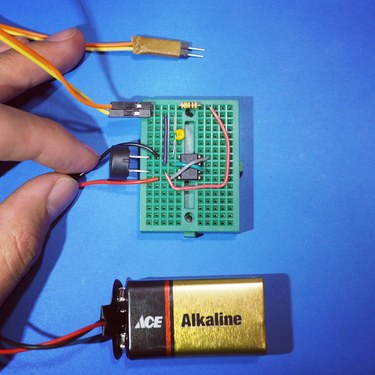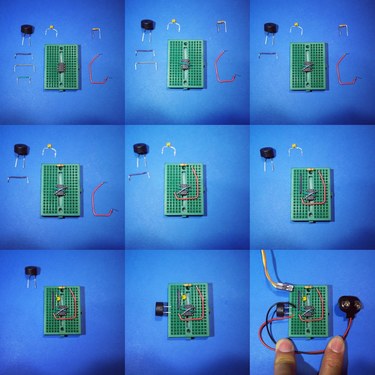## What Does It Do? **The Coqui: a simple device to read a sensor via an audible tone.** We're exploring using audio frequencies to convey sensor readings -- like a modem, but even simpler -- in order to make sensor readings more accessible for people (or to enable data transmission over ubiquitous audio jacks on PCs and smartphones). ## Latest version The [latest and simplest version of the Coqui](/notes/warren/03-01-2019/build-a-sound-generating-coqui-conductivity-sensor) can be seen in the following images. This version differs from [the previous](/notes/ashkaya/09-17-2016/build-a-coqui-a-simple-water-conductivity-sensor) in a few ways: * smaller, cheaper circuitboard (breadboard) * fewer wires * flatter wires which make it easier to see the circuit However, the circuit is fundamentally the same! Click these images to enlarge: [](/i/28988?size=original) [](/i/32338?s=o) ## Assemble the Coqui Here are a few guides to building different versions of the Coqui: [notes:grid:activity:coqui] ## Coqui versions The Coqui has been refined, remixed, and modified plenty over the years. [activities:coqui-version] ## Modify the Coqui [activities:coqui-mods] ## Do something with the Coqui Once you've built a Coqui, here are a few things you can do with it: [notes:grid:activity:coqui-usage] Add an activity or request an activity guide you don't see listed **** ## Frequently Asked Questions [questions:coqui] **** [](https://i.publiclab.org/system/images/photos/000/007/410/original/coquibb.JPG) A Coqui is a simple, inexpensive, open source device that generates an audible tone that is based on any electric resistance-based measurement. For example, a Coqui can measure: * conductivity of liquids * temperature * ambient light ## Build a Coqui Instructions on the breadboard-based "BBv1.0" edition of the Coqui can be found here: http://publiclab.org/notes/donblair/09-30-2014/coqui-bbv1-0 ### Notes - The github repo for a more permanent printed circuit board version of the coqui is [here](https://github.com/OpenWaterProject/coqui) The Coquí is a circuit that allows you to 'hear' the readings from various sensors. Once the Coquí is assembled, you'll be able to 'hear' the conductivity of a solution, the temperature of a room, or the color of a pH test strip. The design was named (onomatopeically) after the several species of small frogs which have a loud, distinctive call at night. ### Demo Coqui applications - [Testing the conductivity of a solution](http://publiclab.org/notes/donblair/09-30-2014/coqui-bbv1-0-testing-conductivity-of-a-solution): - [Reacting to an LED with sound](http://publiclab.org/notes/donblair/09-30-2014/coqui-bbv1-0-reacting-to-an-led-with-sound): - [Assessing ambient light levels](http://publiclab.org/notes/donblair/09-30-2014/coqui-bbv1-0-assessing-ambient-light-with-a-photoresistor): - [Assessing temperature with a thermistor](http://publiclab.org/notes/donblair/09-30-2014/coqui-bbv1-0-using-a-thermistor-as-a-temperature-probe): - [Sending water quality voicemails with a coqui using vojo.com](http://publiclab.org/notes/donblair/09-10-2014/water-quality-coqui-voicemails): [](http://publiclab.org/notes/donblair/09-10-2014/water-quality-coqui-voicemails) ### Building your own Coqui - [Coqui BBv1.0](http://publiclab.org/notes/donblair/09-30-2014/coqui-bbv1-0): a breadboarded version of the Coqui ### Building Coqui sensors - Making a conductivity probe from a [bottle cap and two metal screws](http://publiclab.org/notes/donblair/09-30-2014/making-a-diy-conductivity-probe-from-a-water-bottle-and-metal-screws) ## Parts list See the initial parts list here: #13459 and #11209 for a DigiKey shopping cart link at $19 per kit. And @kanarinka mentions: > there are a couple other things that are helpful to have that are not shown (like the probe made from the top of a water bottle with two screws in it and alligator clips to attach that to the breadboard) Scans of an invoice from DigiKey: [](https://publiclab.org/system/images/photos/000/023/760/original/Screenshot_2018-02-28_at_9.59.17_AM.png) [](https://publiclab.org/system/images/photos/000/023/761/original/Screenshot_2018-02-28_at_9.59.46_AM.png) ...
| Author | Comment | Last activity | Moderation | ||
|---|---|---|---|---|---|
| xose | "Añadir clavija al sensor Coqui para grabar las mediciones: https://publiclab.org/notes/imvec/07-02-2022/anadir-jack-al-coqui-para-grabar-mediciones..." | Read more » | over 2 years ago | |||
| imvec | "Just noticed this jeff! Awesome! " | Read more » | over 2 years ago | |||
| alejobonifacio | "Reading a little more I found that you could change the frequency of the PWM in arduino. I did not try to do this. " | Read more » | over 2 years ago | |||
| alejobonifacio | "Hi! good question! The frequency of PWM of arduino is about 500hz. Is that enough for conductivity measurement? " | Read more » | over 2 years ago | |||
| JasmineKurb | "Wow, This is amazing. Science is completely based on experiments. If you are staying science then you should know how to do experiments and you mus..." | Read more » | over 2 years ago | |||
| Ag8n | "The conductivity cell should take the place of Rx. So disconnect the conductivity cell, disconnect Rx, leave the one of the conductivity cell conn..." | Read more » | over 2 years ago | |||
| alejobonifacio | "Thanks @Ag8n for the explanation! I am learning a lot! :nerd_face: " | Read more » | over 2 years ago | |||
| alejobonifacio | "Hi @Ag8n! What you suggest sounds interesting. Would it be something similar to the attached diagram? " | Read more » | over 2 years ago | |||
| Ag8n | "Further note-EC is electrical conductivity " | Read more » | over 2 years ago | |||
| Ag8n | "Especially in mixtures, not all soluble solids are conductive. So yes, you can dissolve (or sometimes suspend) something inert in water. We would..." | Read more » | over 2 years ago | |||
| warren | "This is very cool! I do wonder if TDS is going to be consistently correlated with conductivity -- i may just not be well informed but isn't it poss..." | Read more » | over 2 years ago | |||
| Ag8n | "Look up conductivity cell and wheatstone bridge Instead of feeding DC into the weatstone bridge, the audio signal is fed in. One leg of the wheats..." | Read more » | over 2 years ago | |||
| alejobonifacio | "Thanks for your suggestion @Ag8n, sounds very interesting to try. Anyway I have to be honest and say that I don't quite figure out how to do what y..." | Read more » | over 2 years ago | |||
| Ag8n | "It looks like the Coqui is a pretty well designed instrument. But, some of the pharmaceutical instruments would send the tone through a bridge. T..." | Read more » | over 2 years ago | |||
| alejobonifacio | "Hi @warren! Yes, 0.1-1 g/L is a useful range at least in rivers in this part of the world, in fact for this river test it worked well. I still have..." | Read more » | over 2 years ago | |||
| liz | "Thank you for this close and careful work <3 " | Read more » | over 2 years ago | |||
| warren | "Hi @alejobonifacio i wonder if there is an 'ideal' range if we can use resistors or capacitor sizes to shift that to our looked-for "search range" ..." | Read more » | over 2 years ago | |||
| fooddieto675 | "The telecommunications network allows the exchange of data. Here the computers are linked and the linked computers can share the data.excellent pos..." | Read more » | over 2 years ago | |||
| liz | "Thank you! I added the tag lang:cz to indicate this was Mandarin language content " | Read more » | almost 4 years ago | |||
| amocorro | "@amocorro awards a barnstar to imvec for their awesome contribution! " | Read more » | almost 4 years ago | |||
| EllenHarri | "Good Work, Keep it up. " | Read more » | almost 4 years ago | |||
| pfubochka | "Wow that's sounds really helpful. But sometimes issue cannot be solved so easily. We should find other ways in our community here at forextime " | Read more » | about 4 years ago | |||
| stevie | "Got it. I've had this coqui for about three years. I've used it probably 5 times. I didn't realize these things had a shelf life like that. Thank ..." | Read more » | over 4 years ago | |||
| silentsairam | "@stevie : 1. 555 timer lifetime is close to 1000 hours with/without battery. 2. If the same electrodes have been used for all testing/analysis, s..." | Read more » | over 4 years ago |